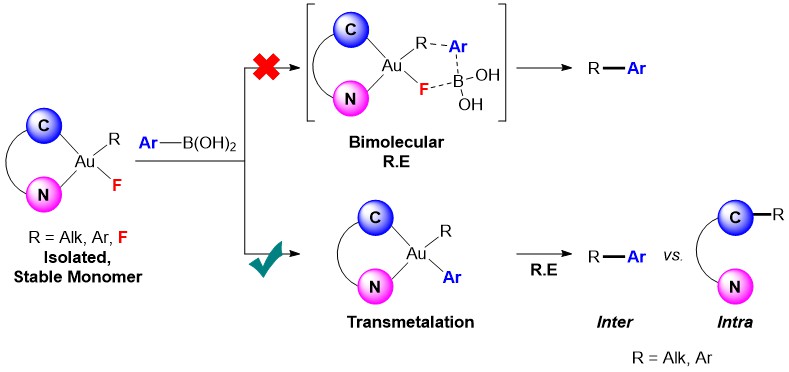How Boronic Acids Interact with Gold(III)-Fluorides: A Mechanistic Investigation
In the past decade numerous AuI/AuIII catalyzed transformations have been developed in order to construct C-C, C-X and C-F bonds.1 Many of these reactions use Selectfluor (an electrophilic fluorinating reagent) as a sacrificial oxidant and aryl boronic acids as coupling partners. In these processes, it has been proposed that gold(III) fluorides intermediates react with boronic acids via a bimolecular reductive elimination pathway or transmetalation followed by reductive elimination to deliver the product.2-3 However, due to highly reactive nature of AuIII-F species, these mechanistic proposals still lack experimental support. Here, we present our results on the preparation and characterization of a series of novel (C^C^N) and (C^N)-stabilized gold(III) fluorides in monomeric form and an in depth study on their reactivity with aryl boronic acids where we observe and isolate the transmetalation product.4-5 Importantly, this novel (C^C^N) pincer type gold(III) framework enable the synthesis of first stable gold(III) formate complex which open a way towards homogeneous gold catalyzed dehydrogenation of formic acid.6

[1] Kumar, R.; Nevado. C. Angew. Chem. Int. Ed. 2017, 56. 1994-2015 .
[2] Mankad, N. P.; Toste, F. D. J. Am. Chem. Soc. 2010, 132, 12859-12861.
[3] Wu, Q. ; Du, C. ; Huang, Y. ; Long, Z. ; Song, F. ; You, J. Chem. Sci. 2015, 6, 288-293.
[4] Kumar, R.; Linden, A.; Nevado. C. Angew. Chem. Int. Ed. 2015, 54, 14287-14290.
[5] Kumar, R.; Linden, A.; Nevado. C. J. Am. Chem. Soc. 2016, 138, 13790-13793.
[6] Kumar, R.; Krieger, J.-P.; Bengoa, E. -G.; Linden, A.; Nevado. C. Angew. Chem. Int. Ed. Under revision